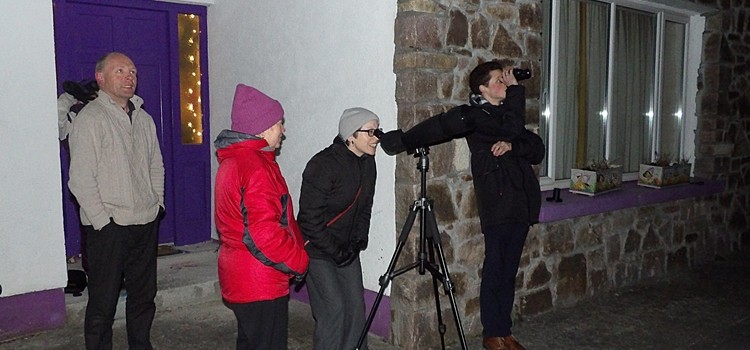Have you spotted Jupiter in our lovely clear skies this week? It is very bright and visible to the naked eye. We got the kids out of bed at nine O’ clock last night just to have a look (they may have been more interested in running around in the dark than in actually looking up at the sky!).
This was our view from our front door, a lovely full moon and Jupiter up above it (I obviously don’t have the steadiest hand as Jupiter looks more like a squiggle line than a round object, but you get the idea)…

Jupiter is one of the brightest objects in our night skies (after the Moon and Venus), and is particularly bright at the moment as the (almost full) moon swings near it.
Easy to see with the naked eye, some of its moons are also visible when viewed through a binoculars. We couldn’t view them this way (more shaky hands) but, luckily Mr. Science Wows had the telescope all set up and ready and then we got a real treat.

We were able to see three of Jupiter’s moons, as well as the striped appearance of this giant planet. Quite a spectacle.

Here are some more facts about this amazing planet…
- Jupiter is the largest planet in our solar system, it could fit more than 1,300 Earths inside it!
- It is the fifth planet from the Sun.
- Jupiter is thought to have 67 moons (50 confirmed moons and 17 yet to be confirmed), three that are visible at the moment are part of the Galilean moons, so called after the man who first discovered them, in 1610. There are four Galilean moons orbiting Jupiter, in total, and these are the largest of Jupiter’s satellites; Ganymede, the largest of these moons is larger than the planet Mercury, and is the only moon known to have its own magnetic field. Europa, another Galilean moon orbiting Jupiter, is of great interest as it contains water, up to twice as much water on Earth in fact, making it a possible habitable zone.
- Jupiter has three, faint, outer rings.
- Jupiter is a gaseous planet. At its outer point temperatures are thought to be about -145 degrees celsius. Deeper within the planet, hydrogen and helium becomes the dominant gas and temperatures rise. Deeper still and the hydrogen gas turns to liquid and it is thought that, at its core, temperatures of up to 35,000 degrees celsius result in metallic hydrogen that generates electricity, creating a magnetic field.
- Jupiter’s surface appears to be covered in stripes and swirls, these are raging storms. One of them, the Great Red Spot, is larger than Earth and has been raging for hundreds of years.
- The first visits to Jupiter was made by the Pioneer 10 spacecraft, as it flew by in 1973. Since then there have been eight more missions, the latest by the Juno spacecraft which is on course to arrive at the giant planet on July 4th 2016.
